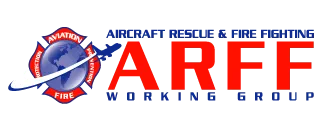
By Jonathan Miller
The Aircraft Rescue & Fire Fighting Working Group (ARFFWG) held its first-ever summit at FDIC International Tuesday at the JW Marriott Indianapolis.
The ARFFWG is a non-profit membership organization established in 1990 to promote the science and improve the methods of aviation fire protection and prevention, according to the organization’s Web site. The organization exists for the benefit of fire protection personnel around the world who work at airports or work with aircraft and/or who can reasonably be expected to be involved with some type of aviation/aircraft related emergency event.
The meeting followed the agenda laid out for the 32 attendees for the first half. Topics discussed included National Fire Protection Association (NFPA) 440, Guide for Aircraft Rescue and Firefighting Operations and Airport/Community Emergency Planning, standard, pre-incident planning and ARFF personnel responsibilities.
But after a short coffee break, the second-half agenda was set aside and everyone at the conference brought up the topics that pertained to their fire departments and airports.
Jason Schnase served as the summit’s master of ceremonies. Schnase is the battalion chief with the Port of Seattle Fire Department and is the Section 6 Director of ARFFWG.
Schnase encouraged setting the second-half agenda aside and discussing the topics that were top of mind of the attendees.
The hot topic was Fluorine-Free Foam (F3) and the best practices for cleaning ARFF vehicles transitioning from aqueous film forming foam (AFFF). Some wanted to know how to train with the new F3. It was also revealed in the group discussion that the Environmental Protection Agency (EPA) is offering funding to help rid ARFF vehicles of PFAS foam.
The summit kicked off with Schnase announcing that the most important thing he wanted the attendees to get out of this conference was: Fire departments, airport operations, airlines, municipalities, and police departments need to be in communication and coordination for pre-emergency planning.
“Unified command is huge when it comes to aircraft emergencies,” Schnase said.
How does one go about getting all these agencies to work together? Schnase and Chris Menge, an Albany (NY) Fire Department captain and second vice chair with ARFFWG, said fire departments must lead the planning. One attendee said his department got the ball rolling by inviting airport management to the firehouse for breakfast.
The first item on the summit agenda was NFPA 440, which has been the ARFF standard since 2010. Rob Mathis, Portland (OR) Airport Fire and Rescue chief, was the guest speaker on NFPA 440, who appeared remotely. He said NFPA 440 is a good document that lays out planning for an airport emergency.
Mathis relayed that 80 percent of all impact crashes occur on or within 2,000 feet of the runway. He said 15 percent of impact crashes occur in the approach areas.
“At any kind of aircraft accident you’re going to need mutual aid,” Mathis said. “440 is a good way to lay a foundation.”
With drones becoming ever-present, whether it be police, fire, or delivering goods and services, “All fire departments are going to be involved in the near future with aircraft,” Mathis said.
The next speakers were Marc Tonnacliff and Jim Price, ARFF Specialists with the Federal Aviation Administration (FAA), who said electric airplanes are coming.
“The standard for electric vertical takeoff and landing aircraft (eVTOL), has not been created,” Tonnacliff said. “We’re still studying it.”
Schnase concluded the day’s session also talking about the future.
“We’re going to be The Jetsons sooner rather than later,” Schnase said. “Larger cities like New York, Dubai, and Los Angeles may be the first locations to see the eVTOL aircraft. Commercial air taxi services may begin as early as 2025.”
Schnase encouraged the attendees to get on any committee that’s out there to learn how to interact with this new aircraft. ARFFWG, Schnase said, is good about working with government agencies on these issues.
ARFFWG’s main mission with this summit is to provide education, Menge said. All the attendees come from smaller airports. Menge said the bigger airports are already members of ARFFWG.
“We’re trying to spread the word and hopefully get [the smaller airports] to join ARFFWG. But, this isn’t a sales pitch. We’re here to provide information and resources that will live beyond this summit.”

